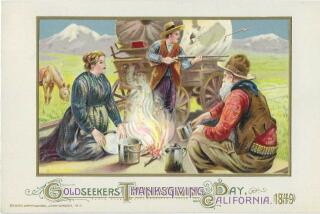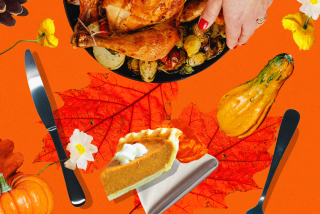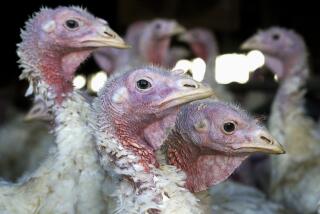Talking Turkey
It was like a college exam, except this time I actually studied.
I knew that an unstuffed 12-pound turkey, roasted at 325-degrees Fahrenheit, would take between four and five hours to cook. I knew that a turkey is best when covered with cheesecloth or a rag while in the oven, so its juices don’t completely escape.
And close by my side, I had the phone numbers of the Butterball Turkey Talk-Line, the Foster Farms Turkey Helpline and the USDA Meat and Poultry Hotline.
Nobody could tell me I wasn’t prepared to cook my first Thanksgiving bird.
Most importantly, in preparing for this test of man against frozen beast, I had spent the previous afternoon in the massive kitchen at Oxnard High School for a private session with Harry Brockwell and Mike Lodi.
Brockwell, a longtime Ventura County caterer, is a certified executive chef of the American Culinary Federation. Lodi, also a member of the federation, is cafeteria manager at the high school. The turkey and I were in good hands.
When I arrived at the school, both men were dressed in white chef’s smocks and toques (which I soon was to don as well) for our trial run of a Complete Thanksgiving Dinner for the Completely Unculinary: an 18-pound bird, dressing, gravy, mashed potatoes, candied yams, peas, cranberry sauce and sunflower-shaped turnips.
(Yes, Brockwell let me carve my own turnip flowers and no, they didn’t particularly look like turnip flowers when I was done with them.)
Brockwell had brought with him two 18-pound turkeys--one which we would prepare together, the other which he began cooking about two hours before my arrival.
Tips for Preparing and Cooking Your Own Thanksgiving Turkey
TIP NO. 1: Get someone to begin preparing it two hours before your arrival.
“What we’re doing today is plain vanilla,” said Brockwell, meaning the bird wasn’t going to be smoked, barbecued, deep fried (the “in” technique this year), sauteed, or tweaked in any way.
“What we are doing here has been done for 300 years,” Brockwell said. “All we are doing is oiling it down on the outside and salt and peppering it on the inside.”
With the knowledge that if all else failed, there was already that earlier roasting bird (see Tip No. 1), I was ready to proceed.
Our first job was to prepare the dressing for the bird cooking in the oven. It would be a mixture of chopped stale bread crumbs, onions, celery and turkey broth, covered with aluminum foil and baked outside, but in proximity of, the turkey. Cooking the dressing inside the turkey adds an additional 1-1 1/2 hours roasting time to the bird, Brockwell said.
Next we removed the turkey from the oven and filled its cavity with a mixture of onions, celery, carrots and turkey stock. We then basted the turkey, pouring its drippings over the rag in which it was wrapped.
“The cloth is like a shroud,” Brockwell said. “It holds the juices there and keeps it moist.”
We basted about two hours into the cooking process, but the timing can vary, Brockwell said.
“When you look in [the oven] and see the turkey is dry, it’s time to baste,” he said. “Usually, cooks baste whenever they remember to.”
*
TIP NO. 2: Concentrate. Don’t forget what your bird is up to.
After we basted bird No. 1, we prepped bird No. 2 for its entry into the oven. We spread salt and pepper lightly around the inside of the bird and then tied its legs together and pinned its wings to its body so that it would maintain its shape while roasting. With both birds cooking, we set our sights on the candied yams: a layer of yam slices, topped by a layer of orange slices, topped by a layer of marshmallows, topped by a layer of yam slices, topped by a layer of orange slices, topped by a layer of marshmallows. It is baked at 325 degrees for a couple of hours and when done, marshmallows are again added to the top and browned.
While Brockwell and I worked on the turkey and dressing, Lodi mashed some potatoes. We boiled peas, opened a can of cranberry sauce and covered the boiled turnips with brown sugar and nutmeg and heated them in a pan.
Brockwell peeked inside the oven and declared that bird No. 1 was cooked. Through vast experience, he can tell with a fair degree of accuracy when the bird is likely to be done, he said, but just to make sure, he checks the flexibility of the turkey’s joints to see if it is thoroughly roasted.
*
TIP NO. 3: If it’s cooked sufficiently, its joints will be nice and soft. If it’s undercooked, its joints will be stiff. (Addendum: If the cook’s joints are stiff, order out.)
I left Oxnard High School (with my souvenir chef’s hat and a container of food) buoyed by the success of the day, but doubting seriously whether I could replicate it at home the following day.
And the following day arrived much too quickly.
I had begun the defrosting process by placing my frozen 12-pound L’il Butterball in the empty sink the night before. Now it sat there, intimidating the hell out of me each time I walked through the kitchen.
After running to the grocery store to buy the last few essentials--like a pot to roast in, pepper, carrots, celery and headache medication--I was ready to take the challenge.
I put on my chef’s hat (Brockwell had said chefs always dress the part, it helps get them in the mood) and unwrapped the bird. I washed the turkey, removed its organs and placed them in a pot of water to make turkey stock. Then I turned on the oven.
After rubbing in the salt and pepper, placing the turkey in a buttered-up pan and removing the cat from inside the oven (he got a bit over-curious) I inserted the bird.
And waited. And waited. And waited.
*
TIP NO. 4: Bring some reading material--it’s going to take awhile.
I basted two hours into the process and filled the turkey cavity with the vegetable-broth mixture. I basted again about an hour later and waited some more. I felt like an expectant father: pacing and fidgeting.
At the five-hour mark, I was ready to retrieve--and taste--the bird.
Whether it was delicious, adequate or barely edible, I can’t really say. I’m still alive, so that’s a pretty good sign.
What I can say definitively, however, is that it tasted a lot like chicken.
More to Read
Eat your way across L.A.
Get our weekly Tasting Notes newsletter for reviews, news and more.
You may occasionally receive promotional content from the Los Angeles Times.









